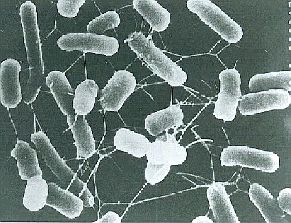Tokyo Food Safety Information Center » Good things to know » The microorganisms which cause food poisoning » Other diarrhetic E. coli
Other diarrhetic E. coli(Escherichia coli)
Characteristics

E. coli lives in the digestive tracts of people and animals and, under normal circumstances, does not cause illness. However, several varieties of E. coli cause sickness in humans; collectively, they are known as diarrhetic E. coli (also called pathogenic E. coli). Currently, these varieties are divided into the following five categories.
Types and symptoms of diarrhetic E. coli
- Enteropathogenic E. coli (EPEC): Symptoms are diarrhea and stomach pain; causes acute gastroenteritis very similar to salmonella.
- Enteroinvasive E. coli (EIEC): Enters the cells of the intestines and causes symptoms similar to dysentery (bloody stool, stomach pain, and fever).
- Enterotoxigenic E. coli (ETEC): Causes intense watery diarrhea similar to cholera via enterotoxin.
- Enterohemorrhagic E. coli (EHEC): Causes hemorrhagic enteritis, including stomach pain and bloody stool, via verotoxin. Also called Verotoxigenic E. coli (VTEC).
- Enteroaggregative E. coli (EAEC): Attaches to the cells of the intestines and produces enterotoxin, causing sporadic diarrhea.
Which foods can cause diarrhetic E. coli infection?
Diarrhetic E. coli may be carried by people and livestock and secondary contamination caused by food and hands contaminated by fecal matter from the same can result in food poisoning from any number of foods.
What are the symptoms of diarrhetic E. coli infection?
The incubation period for EPEC and ETEC is 12 to 72 hours and 1 to 5 days for EIEC and EAEC (almost always within 3 days), while for EHEC it is from 4 to 8 days. The primary symptoms are stomach pain, diarrhea, fever (38-40° C), vomiting, and headache.
What are the key points to preventing diarrhetic E. coli infection?
- Thoroughly wash vegetables and other foods and cook meat thoroughly to ensure the penetration of heat to its center before eating.
- Frequently inspect foods stored in your refrigerator and eat them as early as possible after purchase.
- Be sure to always thoroughly wash and disinfect cooking implements and hands to prevent secondary contamination of cooked foods.
- When drinking or cooking with water other than that received directly from a tap, be sure to have its quality tested at least once a year to check whether it is still safe to consume.
- Periodically clean and conduct inspections of building water tanks, etc.